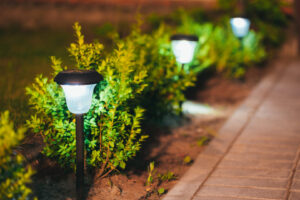
Here are a few tips about resolving several common outdoor lighting problems.
Outdoor lighting provides the freedom to enjoy your property whenever you’d like, adds security, and makes your dream backyard a reality. However, it also comes with its own set of problems. Because it is outside, weather and pests can damage your outdoor lighting, resulting in malfunctions. To maximize the benefits and minimize the risks, you must identify issues with your outdoor lighting and prevent them from happening in the first place. We have a few tips about resolving several common outdoor lighting problems.
Outdoor Lights Burn Out Too Fast
Lighting fixtures exposed to rain, snow, and wind are prone to premature light bulb burnout. Water and dirt can enter the fixture, corrode the socket, or cause a bad connection.
Always use outdoor-rated bulbs for fixtures exposed to the elements. These bulbs have seals to protect against moisture and fogging, as well as from corrosion and premature failure.
There are different types of outdoor bulbs: wet-rated or damp-rated. Wet-rated bulbs can withstand rain, dripping water, or standing water, making them ideal for walkways, stairs, and garden beds. Damp-rated bulbs can combat some moisture but not direct exposure to water. Suitable locations for these include covered porches and decks.
Animal Damage
Small bugs, like fire ants, are drawn to electricity and like to build their homes around electrical fixtures. Additionally, squirrels and rabbits often chew through exposed wires. These pests can get inside lighting fixtures even if they are tightly sealed. Pests can also get into transformers for outdoor lighting systems, which can cause considerable damage.
Pouring white vinegar in and around the mound is a simple DIY method for eliminating fire ants. Another solution is replacing the bulbs with low-heat LEDs so insects cannot detect them. To avoid squirrel damage from chewing through wires, you could spray the wires with hot pepper spray to give squirrels a burning taste so they avoid the cables in the future. If you haven’t set up your lighting system yet, burying the wires underground may be a good idea.
Flickering Lights
Flickering lights are typically caused by a faulty socket connection or a defective light bulb. A bad bulb can lead to overheating or burning. A bulb that’s been in use for too long often produces an inconsistent light level, creating the appearance of flickering. You should always check the lighting connections before replacing bulbs.
If you believe a faulty connection is the cause of your problem, shut off the fixture’s power and tighten all connections in the socket. If that doesn’t work, you’ll need to replace the light socket with a new one with a built-in ground wire.
Failing Connectors
Connectors are typically placed in protected areas, away from hazards like high winds or storms. Exposure to the elements may fray the wires, potentially leading to a fire hazard. Because of the risks, you should call a professional lighting expert to mitigate any dangers in your lighting system. Focus on prevention and look out for any signs of disruption in your connectors or wires.
Corrosion
Most standard outdoor lighting fixtures contain rubber weatherproof seals, which can deteriorate over time due to age and exposure. Once the seal fails, the socket will be exposed to the elements and more likely to corrode. Corrosion is also more likely to form when the wiring is exposed to water.To prevent corrosion, invest in lighting fixtures designed to minimize trapped moisture. Draining the water more efficiently can help prevent socket corrosion. Additionally, getting weather guards to waterproof them further can increase this security. If your fixture already has moisture buildup, your seal likely needs replacing. If the socket is already corroded, it will need replacing as well.
Questions? Lehnhoff’s Supply is Here to Help
If you still have more questions about solving common outdoor lighting problems, the trained professionals at Lehnhoff’s Supply are here to help you.
Find us at 2708 Belair Road, Fallston, MD 21047 and give us a call at 410-510-7646. For tips, tricks, and to see what we have been up to, be sure to follow us on Facebook, X – Twitter, and Pinterest!
We serve but aren’t limited to, the following parts of Maryland: Harford County – Fallston, Forest Hill, Joppa, Edgewood, Bel Air, Churchville, Havre de Grace, Jarrettsville, Street, Aberdeen, Abingdon, and Joppatowne. In Baltimore County: Kingsville, Perry Hall, Overlea, Fullerton, Nottingham, Parkville, Towson, Carney, Loch Raven, Lutherville, Timonium, Hunt Valley, Cockeysville, Sparks, Glyndon, Pikesville, Reisterstown, Ruxton, Parkton, Glen Arm, Baldwin, Monkton, Long Green, White Marsh, Rosedale, Phoenix, and Fork.
